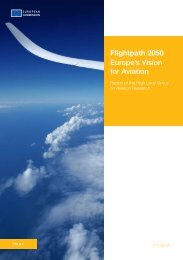Create
Final Report - Acare
Final Report - Acare
- No tags were found...
You also want an ePaper? Increase the reach of your titles
YUMPU automatically turns print PDFs into web optimized ePapers that Google loves.
46<br />
to be brought to a point of understanding<br />
and rational description that will allow it<br />
to be fairly and properly judged on its own<br />
merits. If successfully incubated, an idea will<br />
have enough substance for a research plan<br />
to be placed in the mainstream for funding.<br />
It has been identified by the CREATE project<br />
as a ‘missing link’ in the stream of research<br />
processes that are in operation today.<br />
The development and execution of an<br />
incubation process is the principal focus within<br />
the CREATE recommendation with supporting<br />
processes as steps towards it. Without an<br />
incubation stage the element presently missing<br />
to stimulate successful innovation would still<br />
be missing. At the end of the incubation phase,<br />
a result will be delivered, which will either<br />
allow the idea to be prepared for mainstream<br />
research or will show that the idea can never<br />
be feasible – either outcome is useful.<br />
The CREATE team places great emphasis<br />
on the incubation phase being a period of<br />
protected financial support. It is clear from<br />
experience that all innovative proposals face<br />
substantial opposition. It is always open to<br />
this opposition to apply pressure for the<br />
removal of funding because “nothing has<br />
been achieved” or similar expressions. In<br />
making recommendations about incubation<br />
the CREATE team believes that the process<br />
should be insulated from having to conform to<br />
development milestone achievements during<br />
what is essentially a structured exploration.<br />
Against this it has to be recognised that the<br />
incubation process may uncover unexpected<br />
features of the technology, the physics or<br />
other matters that destroy any expectation<br />
that the idea will succeed. Clearly in such a<br />
circumstance the project should be wound up.<br />
The context in which the CREATE consortium<br />
thinks that incubation is best suited is in the<br />
area of innovative ideas with high risk (see<br />
Fig. 1, p.15). Incubation will allow these to be<br />
developed to such a level that the ideas can<br />
compete for funding with more incremental<br />
technology developments. The big difference<br />
between innovative systems and evolutionary<br />
progress is their TRL (Technology Readiness<br />
Level) difference. Invariably the innovative<br />
idea initially has a low TRL (in the 0-1 area)<br />
whereas the evolutionary project has a<br />
higher TRL. Usually the obstacles perceived<br />
to challenge the innovative ideas relate to<br />
a relatively small number of major issues.<br />
Incubation should be tightly focused on<br />
these issues and on substantially eroding the<br />
uncertainties that would otherwise be a focus<br />
for opposition (if this is possible).<br />
6.7.2. Objectives<br />
The objectives of the Work Package dealing<br />
with incubation were to explore and to make<br />
recommendations for:<br />
(a) The approaches used for early stage<br />
innovative development across the world<br />
and the particular needs of innovation in<br />
aviation.<br />
(b) The mechanisms that could be applied to<br />
screen a range of ideas before submitting<br />
some of them to incubation.<br />
(c) Possible mechanisms for funding incubation.<br />
(d) Possible mechanisms for executing the<br />
incubation activity.<br />
6.7.3. Funding the Incubation System<br />
A survey of other early stage innovation<br />
mechanisms around the world yielded a<br />
number that sought to overcome some of the<br />
same issues that CREATE has identified. None<br />
of these were a good match for the particular<br />
circumstances that CREATE addresses. They<br />
were either very costly or specifically for<br />
defence (DARPA defence related mechanisms),<br />
were pitched at early stage scientific work<br />
(ERC) or were limited in their funding ratio<br />
(FET-Open). No mechanisms were discovered<br />
that addressed together the particular issues of:<br />
a) The probability of multi-disciplinary solutions.<br />
b) The certainty of multi-sector engagement<br />
in the emergent solution.<br />
c) A likely into service date more than 30<br />
years ahead.<br />
d) An overall funding regime that supported<br />
the concept of incubation.<br />
It is the combination of these issues, identified<br />
in section 3. above, that makes innovation in<br />
this field necessary but impossible to achieve<br />
with existing mechanisms.<br />
The mechanism that is needed would have the<br />
following attributes:<br />
a) A funding ratio (the proportion of public<br />
funds involved) of close to 100% but<br />
limited to the duration of the exploratory<br />
research of the incubation period.<br />
b) A short life (up to 2-years) to emphasise the<br />
need to address specified key issues only. It<br />
is likely that the key challenges to a concept<br />
could be explored and examined within this<br />
period if they are going to be convincing.<br />
c) A modest budget – the CREATE team



